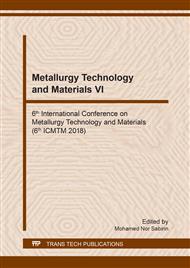[1]
E. Taupin, J. Breitling, W. T. Wu, T. Altan, Material fracture and burr formation in blanking results of FEM simulations and comparison with experiments, J. Mater. Process. Tech. 59 (1996) 68-78.
DOI: 10.1016/0924-0136(96)02288-1
Google Scholar
[2]
H. S. Liu, M. W. Fu, Prediction and analysis of ductile fracture in sheet metal forming--Part II: Application of the modified Ayada criterion, Int. J. Damage. Mech. 23 (2014) 1189-1210.
DOI: 10.1177/1056789514541559
Google Scholar
[3]
J. Hulka, P. Kubik, J. Petruška, Ductile Fracture Criteria Calibration and their Application, Adv. Mater. Res. 468-471 (2012) 1049-1052.
DOI: 10.4028/www.scientific.net/amr.468-471.1049
Google Scholar
[4]
H. Takudaa, K. Morib, N. Hatta, The application of some criteria for ductile fracture to the prediction of the forming limit of sheet metals, J. Mater. Process. Tech. 95 (1999) 116-121.
DOI: 10.1016/s0924-0136(99)00275-7
Google Scholar
[5]
Y. Lou, H. Huh, S. Lim, K. Pack, New ductile fracture criterion for prediction of fracture forming limit diagrams of sheet metals, Int. J. Solids. Struct. 49 (2012) 3605-3615.
DOI: 10.1016/j.ijsolstr.2012.02.016
Google Scholar
[6]
L. P. Lei, J. Kim, B. S. Kang, Bursting failure prediction in tube hydroforming processes by using rigid–plastic FEM combined with ductile fracture criterion, Int. J. Mech. Sci. 44 (2002) 1411-1428.
DOI: 10.1016/s0020-7403(02)00045-0
Google Scholar
[7]
C. Wang, J. Chen, C. Xia, F. Ren, J. Chen, A New Method to Calculate Material constants of Ductile Fracture Criteria for Advanced High-Strength Sheet Blanking, J. Mater. Eng. Perform. 23 (2014) 1296-1306.
DOI: 10.1007/s11665-013-0861-z
Google Scholar
[8]
Y. Yang, Y. U. Zhongqi, L. I. Xuechun, Z. Sun, A New Ductile Fracture Criterion and Its Application to the Prediction of Forming Limit in Deep Drawing, J. Mater. Sci. Technol. 19 (2003) 217-219.
Google Scholar
[9]
H. Liu, Y. Yang, Z. Yu, Z. Sun, Y. Wang, The application of a ductile fracture criterion to the prediction of the forming limit of sheet metals, J. Mater. Process. Tech. 209 (2009) 5443–5447.
DOI: 10.1016/j.jmatprotec.2009.04.020
Google Scholar
[10]
M. Zhan, C. Gu, Z. Jiang, L. Hu, H. Yang, Application of ductile fracture criteria in spin-forming and tube-bending processes, Comp. Mater. Sci. 47 (2009) 353–365.
DOI: 10.1016/j.commatsci.2009.08.011
Google Scholar
[11]
A. M. Goijaerts, L. E. Govaert, F. P. T. Baaijens, Evaluation of ductile fracture models for different metals in blanking, J. Mater. Process. Tech. 110 (2001) 312–323.
DOI: 10.1016/s0924-0136(00)00892-x
Google Scholar
[12]
R. Hambli, M. Reszka, Fracture criteria identification using an inverse technique method and blanking experiment, Int. J. Mech. Sci. 44 (2002) 1349–1361.
DOI: 10.1016/s0020-7403(02)00049-8
Google Scholar
[13]
Z. Zhang, X. Kong, M. A. Mirzai, K. Manabe, Determination of Material Constants in Ductile Fracture Criterion for Tubular Materials with Conical Flaring Test, Steel. Res. Int. 88 (2017) No. 5.
DOI: 10.1002/srin.201600258
Google Scholar
[14]
Z. Marciniak, K. Kuczynski, Limit strains in the processes of stretch-forming sheet metal, Int. J. Mech. Sci. 9 (1967) 609-620.
DOI: 10.1016/0020-7403(67)90066-5
Google Scholar
[15]
L. Lang, X. Yang, K. Liu, G. Cai, C. Guo, A calculating model of material constants in ductile fracture criterion and its applications, Acta Aeronaut. Astronaut. Sin. 36 (2015) 672-679.
Google Scholar
[16]
X. Y. Yang, L. H. Lang, K. N. Liu, C. Guo, Modified MK model combined with ductile fracture criterion and its application in warm hydroforming, Trans. Nonferrous Met. Soc. China. 25 (2015) 3389-3398.
DOI: 10.1016/s1003-6326(15)63974-7
Google Scholar
[17]
X. Guo, F. Ma, Q. Guo, X. Luo, N. Kim, K. Jin, A calculating method of tube constants of ductile fracture criteria in tube free bulging process based on M-K theory, Int. J. Mech. Sci. 128–129 (2017) 140–146.
DOI: 10.1016/j.ijmecsci.2017.04.012
Google Scholar


